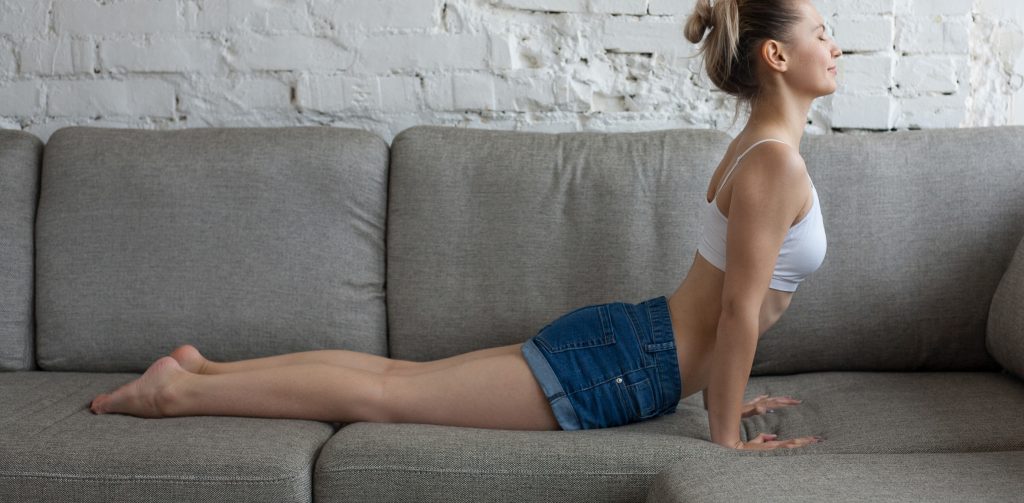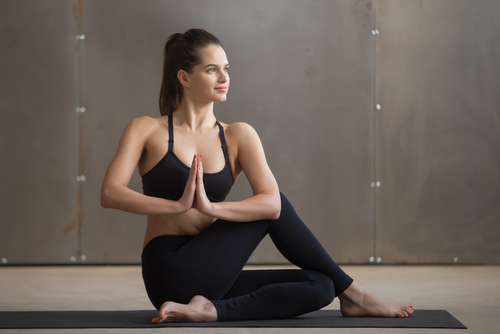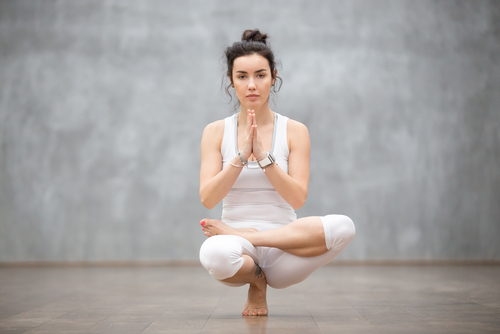As searches for ‘sofa yoga’ surge by 117%, experts share the perfect sofa yoga routine to improve posture and aid wellbeing

From exercise to affirmations, people are always looking for new ways to stay fit and improve their wellbeing. And one type of movement that is currently surging in popularity is sofa yoga.
Furniture retailer DFS has noticed that searches for ‘sofa yoga’ have increased by 117% in the past year, while ‘sofa yoga for seniors’ in particular has seen an increase by 298%.
To shed light on why sofa yoga is increasing in popularity and its benefits, DFS has partnered with yoga expert and teacher Marisse Gaskell, founder of Marisse Yoga, who explains:
“This practice involves doing gentle stretches and traditional yoga poses on the sofa, rather than the traditional mat.
“We all experience the negative effects of prolonged sitting – stiffness, pains and aches, particularly in the neck, shoulders, back, and hips. Sofa yoga works to alleviate this pain and improve posture in a convenient and accessible way. Poses can be adapted to and made easier with a sofa, making it an excellent low-impact option for individuals who are new to the practice, have physical limitations, or who don’t have easy access to fitness equipment.
“The soft yet firm surface means it is ideal for individuals with knee or ankle issues, while the backrest and armrest provide support, deepen stretches, and support alignment.
“Essentially, sofa yoga is a great way to promote joint health and increase your range of motions. What’s more, by taking a break from the constant stimulation of screens and technology and focusing on your breath and body, you can also help to reduce stress and anxiety.”
To help those wanting to incorporate sofa yoga into their daily movement, DFS and Marisse have shared their essential sofa yoga routines. With each pose adaptable to suit different comfort levels and flexibility, this set of stretches is suitable for beginners and certified yogis alike:
Start with your breath
Take a break from the screen and dedicate some time to yourself. Begin by taking a deep breath, inhaling through your nose and exhaling from your mouth.
Breathe slowly and deeply, feeling your abdomen expand on the inhale and sink on the exhale.
Seated Cat Cow (Bitilasana Marjaryasana)
For this first pose, sit comfortably at the edge of your sofa and slowly arch your spine, lifting your chest and dropping your shoulders down and back (Cow). Then round your spine, tucking your chin to your chest and leaning back (Cat). Continue to flow between these two poses for five to ten rounds or until you feel a sense of release.
These movements can help to improve spinal mobility and flexibility, as well as reduce tension and stiffness in the neck, shoulders, and back – a great one if you’ve been sitting still for a long time.
Eagle Arms (Garudasana)
Sit on the sofa while keeping your spine long and feet planted onto the ground. Lift your right arm in front of you and cross the right elbow over your left elbow, bringing the backs of the hands together, or maybe double-crossing your arms to bring your palms together.
You can play around with rising your elbows and pressing your forearms away from your face, as well as taking gentle twists from side to side. Hold eagle arms for a few breaths and switch sides, enjoying both the strengthening and release of tension in your upper back, shoulders and arms.
Seated Side Stretch (Parsva Sukhasana)
Sit comfortably at the edge of your sofa, with your spine straight and your feet on the ground. Put your right hand on the sofa next to your right hip (or you can anchor your hand on the arm or surface of your sofa). Lift your left arm up and over your head, reaching up towards the ceiling and over to the right side, keeping your left hip grounded on the sofa and feeling the stretch in your left side. Look up toward your top hand for an extra stretch in your neck. Hold
for five breaths, release gently, and switch sides.
This is a great way to stretch the shoulders, neck and sides of the body, reduce stiffness and increase flexibility, especially if you’ve been scrolling for a long time and looking down.
Spinal Twists (Vakrasana)

Sitting comfortably with a straight spine, start by reaching both arms up to stretch and then bring your left hand to your right knee or thigh, and your right hand to the back of your sofa. Look over your right shoulder and slowly, gently ease your way into your twist, turning your chest toward the back of the sofa until you feel an appropriate stretch.
Use the back or arm of your sofa, as support or leverage to increase the range of movement and deepen your stretch. Hold for a few breaths and switch sides.
These twists can improve spinal mobility and flexibility, reducing stiffness in the neck, shoulders, and back that is often caused by rounding when sitting at desks or on sofas.
Figure of Four (Eka Pada Utkatasana)

Cross your right ankle over your left knee, so your right knee angles out to the side and your right hip opens. You can deepen the stretch using your hands to gently press down on your right knee, or begin to fold forward bringing your chest closer to your legs. Hold for five breaths, release and switch sides. This is a great pose to try adopting even while watching TV.
Legs-up-the-sofa (Viparita Karani)
Lie with your back on the floor and your legs draped onto the sofa. Let your legs and feet relax, resting your arms wherever feels comfortable for you. Relax your shoulders and neck, and perhaps place a cushion under your head. Stay in this position for five minutes or as long as you like, bringing your attention to your breath.
This pose can relieve stress and tension in the legs and back. It has been known to promote relaxation and improve circulation, as well as alleviate symptoms of fatigue, insomnia, and anxiety.
So there you have it, six sofa yoga poses that are perfect for incorporating wellness into your daily routine. For more guidance on protecting your posture, visit the DFS website at www.dfs.co.uk.





